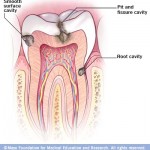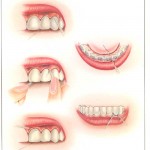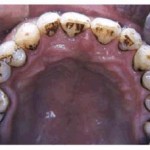
Types of cavities can be classified according to the places which they occur on a tooth
Â
Â
Dental decay is also known as cavities, and they occur when there is dissolution of the teeth surfaces. Our teeth is made up of crystal apatite, and they are very vulnerable to acid which will dissolve them. This organic acid is produced by bacteria found inside our mouth, and they derive the acid from food debris that are left inside our mouth. The three important factors that produce dental decay are bacteria, fermentable carbohydrate, and teeth. Therefore, to prevent formation of dental decay, one of the three factors must not be present in our mouth, as without one of it, formation of the organic acid will be impossible.
Maintaining a good oral hygiene is a very important factor in preventing dental decay. The bacteria in our mouth will adhere to the surfaces of our teeth and form plaque (a thin biofilm of bacteria). By brushing properly and effectively at least twice a day, we are able to mechanically remove plaque and thus, eliminating bacteria. As every human being is genetically different, our teeth are also different from individual to individual. Some people who do not brush as often, will not necessarily form dental decay. On the other hand, some individuals who are vigorously taking care of their teeth, will still be prone to dental decay. Therefore, to say that ‘brush your teeth twice a day’ is a general method that works for most of the population. If you find that you are more prone to dental decay, do pay more attention to your oral hygiene.
To strengthen your teeth further, it is better to use fluoridated toothpaste when you are brushing. However, a minimum of 2 minutes is required for the fluoride to seep into the surfaces of the teeth and be absorbed. There are some toothbrushes in the market now that plays a tune which lasts for 2 minutes while you brush, so that you would know when to stop brushing. A pea sized toothpaste is sufficient for an adult for whole mouth brushing, and children must be supervised by their parents while they are brushing using fluoridated toothpaste. This is to ensure that the child spits out the toothpaste at the end of their brushing to prevent fluoride toxicity.
Flossing our teeth regularly can remove the food debris that are stuck in between our teeth. Brushing only removes the plaque that are found at the sides and on the top of our teeth, as the bristles of our toothbrush is not fine enough to reach in between our teeth. The proper technique of flossing is as follow
- Take a piece of floss around long.
- Twist one end of the floss around your left index finger, and another end around the right index finger. This is to provide you a firm hold on the floss.
- By using your thumbs on each hand, slowly ease the floss in between your teeth by a push and pull motion.
- Once you have reach in between your teeth, pull the floss around the curvature of the teeth.
Other than fluoridated toothpaste, you can also enhance the cleanliness of your mouth with fluoridated mouthwash.
Visiting your dentist regularly once or twice a year for a general dental checkup can also ensure your oral health. Sometimes, even with diligent brushing, flossing, and rinsing, there will still be some other dental disease occurring that we will not be aware of. Some of the patients will only visit the dentist when there is pain due to reasons like expensive dental bills, phobia, etc. This usually means that the disease has progressed into a more advance stage, and by then the treatment provided will be more expensive and unpleasant. Thus, it is better to go for a regular dental checkup whenever it is due.
Eat more vegetables as they can stimulate our salivary flow and can also brush against our teeth surfaces when we chew them. Vegetables are fibrous and they act as natural abrasive substance which is able to clean our teeth. Vegetables are also good for our general health and is cheap.
Stay away from tobacco products, regardless it is in the form of being smoked, or chewed, or others. Tobacco not only can cause dental decay, it is also linked to many other dental and general health diseases, such as tooth staining, bad breath, loosening of the teeth, oral cancer and gum diseases. Tobacco contains high concentration of sugar and sugar is fermentable into organic acid, it also causes decreased secretion of the saliva. Saliva has a protective function over the teeth as it is alkaline in pH, and buffers the low pH produced by the organic acid. This can slow down, or even reverse the progress of dental decay. It also causes vasoconstriction which can mask the effects of inflammation, making inflammation of the gums not noticeable until it is quite severe.


Hello
I Have a plan about Flossing. So I need more info.
Can U help me?!